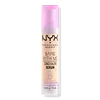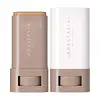NYX Cosmetics Bare With Me Concealer Serum Versus Anastasia Beverly Hills Beauty Balm Serum Boosted Skin Tint
What's inside
What's inside
 Key Ingredients
Key Ingredients

 Benefits
Benefits

 Concerns
Concerns

 Ingredients Side-by-side
Ingredients Side-by-side

Water
Skin ConditioningHydrogenated Polyisobutene
EmollientHydrogenated Polydecene
EmollientPolyglyceryl-3 Diisostearate
EmulsifyingGlycerin
HumectantTrimethylsiloxysilicate
EmollientIsononyl Isononanoate
EmollientDisteardimonium Hectorite
StabilisingButylene Glycol
HumectantSilica
AbrasiveCamellia Sinensis Leaf Extract
AntimicrobialHelianthus Annuus Seed Oil
EmollientTremella Fuciformis Polysaccharide
Emulsion StabilisingCentella Asiatica Extract
CleansingAllantoin
Skin ConditioningSorbitan Olivate
EmulsifyingSorbitan Sesquiisostearate
EmulsifyingGlyceryl Behenate/Eicosadioate
EmollientSodium Chloride
MaskingMagnesium Sulfate
Ethylhexylglycerin
Skin ConditioningPolyhydroxystearic Acid
EmulsifyingTocopherol
AntioxidantPhenoxyethanol
PreservativeCI 77491
Cosmetic ColorantCI 77492
Cosmetic ColorantCI 77499
Cosmetic ColorantCI 77891
Cosmetic ColorantCeramide AP
Skin ConditioningWater, Hydrogenated Polyisobutene, Hydrogenated Polydecene, Polyglyceryl-3 Diisostearate, Glycerin, Trimethylsiloxysilicate, Isononyl Isononanoate, Disteardimonium Hectorite, Butylene Glycol, Silica, Camellia Sinensis Leaf Extract, Helianthus Annuus Seed Oil, Tremella Fuciformis Polysaccharide, Centella Asiatica Extract, Allantoin, Sorbitan Olivate, Sorbitan Sesquiisostearate, Glyceryl Behenate/Eicosadioate, Sodium Chloride, Magnesium Sulfate, Ethylhexylglycerin, Polyhydroxystearic Acid, Tocopherol, Phenoxyethanol, CI 77491, CI 77492, CI 77499, CI 77891, Ceramide AP
Caprylic/Capric Triglyceride
MaskingCoco-Caprylate/Caprate
EmollientEthylhexyl Isononanoate
EmollientTribehenin
EmollientC20-40 Alcohols
EmulsifyingButyrospermum Parkii Butter
Skin ConditioningCorn Starch Modified
AbsorbentPolyester-7
Skin ConditioningLauroyl Lysine
Skin ConditioningPolymethylsilsesquioxane
Simmondsia Chinensis Seed Oil
EmollientHdi/Trimethylol Hexyllactone Crosspolymer
Neopentyl Glycol Diheptanoate
EmollientSilica
AbrasivePolyethylene
AbrasiveCaprylyl Glycol
EmollientCocos Nucifera Oil
MaskingSclerocarya Birrea Seed Oil
HumectantLecithin
EmollientDipalmitoyl Hydroxyproline
Skin ConditioningAstrocaryum Murumuru Seed Butter
EmollientTocopheryl Acetate
AntioxidantHelianthus Annuus Seed Oil
EmollientPentaerythrityl Tetraisostearate
EmollientPalmitic Acid
EmollientRicinus Communis Seed Oil
MaskingSodium Hyaluronate
HumectantHydrogenated Castor Oil
EmollientPolygonum Aviculare Extract
EmollientWater
Skin ConditioningPropylene Carbonate
SolventStearalkonium Hectorite
Gel FormingPalmitoyl Tripeptide-1
Skin ConditioningTocopherol
AntioxidantCI 77891
Cosmetic ColorantIron Oxides
Caprylic/Capric Triglyceride, Coco-Caprylate/Caprate, Ethylhexyl Isononanoate, Tribehenin, C20-40 Alcohols, Butyrospermum Parkii Butter, Corn Starch Modified, Polyester-7, Lauroyl Lysine, Polymethylsilsesquioxane, Simmondsia Chinensis Seed Oil, Hdi/Trimethylol Hexyllactone Crosspolymer, Neopentyl Glycol Diheptanoate, Silica, Polyethylene, Caprylyl Glycol, Cocos Nucifera Oil, Sclerocarya Birrea Seed Oil, Lecithin, Dipalmitoyl Hydroxyproline, Astrocaryum Murumuru Seed Butter, Tocopheryl Acetate, Helianthus Annuus Seed Oil, Pentaerythrityl Tetraisostearate, Palmitic Acid, Ricinus Communis Seed Oil, Sodium Hyaluronate, Hydrogenated Castor Oil, Polygonum Aviculare Extract, Water, Propylene Carbonate, Stearalkonium Hectorite, Palmitoyl Tripeptide-1, Tocopherol, CI 77891, Iron Oxides
 Reviews
Reviews

Alternatives
Ingredients Explained
These ingredients are found in both products.
Ingredients higher up in an ingredient list are typically present in a larger amount.
Ci 77891 is a white pigment from Titanium dioxide. It is naturally found in minerals such as rutile and ilmenite.
It's main function is to add a white color to cosmetics. It can also be mixed with other colors to create different shades.
Ci 77891 is commonly found in sunscreens due to its ability to block UV rays.
Learn more about CI 77891Helianthus Annuus Seed Oil is the oil derived from the seeds of a Sunflower. Sunflower seed oil is non-fragrant. It is an emollient, meaning it helps to soften the skin.
Sunflower seed oil contains many fatty acids. The fatty acids found in sunflower seeds include (from highest amount to least): linoleic acid, myristic acid, palmitic acid, stearic acid, arachidic acid, oleic acid, and linolenic acid.
These fatty acids help the skin create ceramides. Ceramides play a role in repairing the skin barrier.
Helianthus Annuus Seed Oil helps moisturize the skin. This in turn helps the skin look more rejuvenated and smoother.
Sunflowers are rich in vitamin E.
Historians believe Indigenous cultures of North America domesticated sunflowers before corn. Thus they relied on sunflower oil for a variety of uses. One such use is moisturizing skin and hair.
Sunflower seed oil may not be fungal acne safe. We recommend speaking with a professional if you have any concerns.
Learn more about Helianthus Annuus Seed OilSilica, also known as silicon dioxide, is a naturally occurring mineral. It is used as a fine, spherical, and porous powder in cosmetics.
Though it has exfoliant properties, the function of silica varies depending on the product.
The unique structure of silica enhances the spreadability and adds smoothness, making it a great texture enhancer.
It is also used as an active carrier, emulsifier, and mattifier due to its ability to absorb excess oil.
In some products, tiny microneedles called spicules are made from silica or hydrolyzed sponge. When you rub them in, they lightly polish away dead skin layers and enhance the penetration of active ingredients.
Learn more about SilicaTocopherol (also known as Vitamin E) is a common antioxidant used to help protect the skin from free-radicals and strengthen the skin barrier. It's also fat soluble - this means our skin is great at absorbing it.
Vitamin E also helps keep your natural skin lipids healthy. Your lipid skin barrier naturally consists of lipids, ceramides, and fatty acids. Vitamin E offers extra protection for your skin’s lipid barrier, keeping your skin healthy and nourished.
Another benefit is a bit of UV protection. Vitamin E helps reduce the damage caused by UVB rays. (It should not replace your sunscreen). Combining it with Vitamin C can decrease sunburned cells and hyperpigmentation after UV exposure.
You might have noticed Vitamin E + C often paired together. This is because it is great at stabilizing Vitamin C. Using the two together helps increase the effectiveness of both ingredients.
There are often claims that Vitamin E can reduce/prevent scarring, but these claims haven't been confirmed by scientific research.
Learn more about TocopherolWater. It's the most common cosmetic ingredient of all. You'll usually see it at the top of ingredient lists, meaning that it makes up the largest part of the product.
So why is it so popular? Water most often acts as a solvent - this means that it helps dissolve other ingredients into the formulation.
You'll also recognize water as that liquid we all need to stay alive. If you see this, drink a glass of water. Stay hydrated!
Learn more about Water